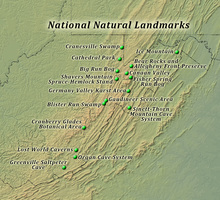 | Back to e-WV
| Back to e-WV
 The West Virginia Encyclopedia
The West Virginia Encyclopedia
 | Back to e-WV
| Back to e-WV
 The West Virginia Encyclopedia
The West Virginia Encyclopedia

West Virginia has 16 National Natural Landmarks, sites recognized for their outstanding biological and geological resources. Administered by the National Parks Service, the program encourages voluntary conservation of sites that are publicly and privately owned. The landmarks in the state include bogs, swamps, old-growth forests, caves, and other geological formations.
The first West Virginia site named to the list was Cranesville Swamp Nature Sanctuary in Preston County and Garrett County, Maryland, which was designated as a landmark in 1964. Many plants and animals common to more northern areas can be found at Cranesville because of its cool, moist conditions. Thirteen other sites were selected between 1965 and 1974. One of the latest to be added was Ice Mountain in Hampshire County, which was designated a landmark on May 18, 2012, when it was one of two sites in the country to be recognized by the U.S. secretary of the Interior on the 50th anniversary of the program. On January 19, 2021, the Bear Rocks and Allegheny Front Preserve was added. The preserve straddles the border between Grant and Tucker counties, and it supports 26 rare and protected species, including the Cheat Mountain salamander.
Six of the West Virginia sites are located within the Monongahela National Forest. They include Big Run Bog in Tucker County, Blister Run Swamp in Randolph County, Cranberry Glades Botanical Area in Pocahontas County, Fisher Spring Run Bog in Tucker County, Gaudineer Scenic Area in Randolph and Pocahontas counties, and the Shavers Mountain Spruce-Hemlock Stand in Randolph County.
There are four cave systems on the list, including Organ Cave and Lost World Caverns in Greenbrier County. Both of these are open to the public. The two other caves are the Greenville Saltpeter Cave in Monroe County, where saltpeter was mined during the Civil War, and the Sinnett-Thorn Mountain Cave System in Pendleton County, which features waterfalls and deep pits. Both Greenville and Sinnett-Thorn are closed to the public.
Other National Natural Landmarks in West Virginia include Canaan Valley in Tucker County, noted for its many wetlands, and Cathedral State Park in Preston County, home to the only stand of virgin hemlock in the state. Another National Natural Landmark is the Germany Valley Karst Area in Pendleton County, which is the most highly developed karst landscape in the Potomac watershed. Karst, which forms on the valley’s soluble limestones, is characterized by caves, sinkholes, and springs.
Written by Becky Calwell